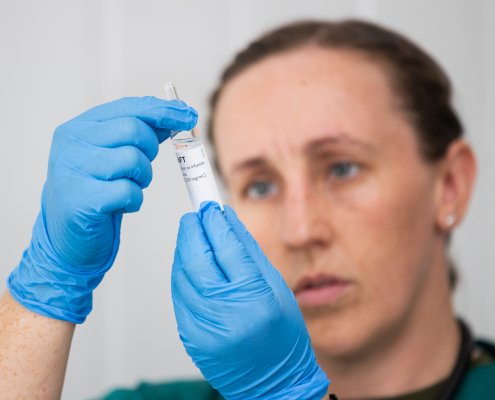Health, Medical and Biosecurity
Infrastructure and expertise for the improved health and protection of Defence personnel including development of medical countermeasure technologies and products to provide effective protection, hazard assessment and treatment for a range of chemical, biological and radiological threats, including pandemics and emerging infectious diseases.
Capabilities and UWA Competitive Advantage
Health
- Human Performance Optimisation through injury management, spinal cord repair, soft tissue regeneration, enhanced cooling from hyperthermia, mechanisms of and delay of muscle fatigue.
- Antimicrobial resistance including developing medical countermeasures for Security Sensitive Biological Agents (SSBAs), and discovery of antibacterial targets and therapies to specific bacteria.
Human Sciences
- Capability to handle and manipulate SSBAs, in vitro testing of novel drugs, virulence screening of biological threat agents at Physical Containment (PC) level 2 laboratories and extensive experience in PC3 experimental and in vivo
- Development of superior sensing technologies for detection of, and methodologies to rapidly identify, decontaminate and eliminate SSBAs.
- Identify, decontaminate and eliminate critical biological threats to food security and food exports.
- Identification of naturally self-decontaminating materials, relevant to the sterilisation of military equipment (vehicles, armament, clothing etc.) following overseas deployments.
- Chemical measurement of stress, assessment tools for screening and early detection of mental health problems and remote health provision using wearables.
- Research and development of innovative radiation protection technologies, such as remote monitoring systems, advanced shielding materials, and real-time dose estimation methods.
- Research on radiation effects and health risk assessments, contributing to the understanding of long-term health risks associated with ionizing radiation exposure (including nuclear).
- Expertise in radiation shielding design including dose limits, materials, and layout optimization. This utilises expertise in radiation physics, computational modelling, and simulation techniques.
- Isotopic characterisation of environmental samples for nuclear safeguarding.
- Development of case-specific nuclear forensics
- Research and development of new tools for nuclear radiation investigations to account for new political situations or requirements.
Key Contacts
Dr Mitali Sarkar-Tyson
Senior Research Fellow, School of Biomedical Sciences, Division of Infection and Immunity, Marshall Centre for Infectious Diseases
Phone: +61 8 6457 2662
Email: mitali.sarkar-tyson@uwa.edu.au
Associate Professor Keith Stubbs
School of Molecular Sciences
Phone: +61 8 6488 2725
Email: keith.stubbs@uwa.edu.au
Outcomes and Impact
- Identification of new antibiotics that are capable of treating a broad range of bio-warfare agents with a reduced chance of developing antimicrobial resistance.
- Development of field deployable diagnostics, and real time biothreat assessment.
- A fingertip blood test that is used to assess muscle microtrauma after training is being commercialised through start-up OxiDx.
- Design of effective radiation shielding systems and shielding requirements including high-dose areas needing additional shielding.
- Comprehensive radiation monitoring programs, both during routine operations and emergency situations, and including identification of potential radiation sources or anomalies.
Facilities
- Researchers have extensive experience in containment level 3 work (PC3) and experience in Physical Containment Level 2 and 3 work in both experimental and animal laboratories.
- Capability to handle and manipulate SSBAs, in vitro testing of novel drugs, also including virulence screening at Physical Containment Level 2 and 3.
- Capability to develop, prepare and test putative medical countermeasures in chemical and biochemical laboratories.
- Experience in using advanced radiation monitoring equipment and techniques to measure and analyse radiation levels, including dosimetry methods to quantify radiation doses received by personnel and ensuring compliance with safety regulations and reducing exposure to as low as reasonably achievable (ALARA) levels.
- Centre for Microscopy, Characterisation and Analysis has state-of-the-art instrumentation (LG-SIMS, ICP-MS) for nuclear forensics.
- The UWA Medical Physics Group has access to specialized radiation protection research/experimental facilities (laboratories, computational resources, and simulation tools) in SCGH and other hospitals and some research centres.



